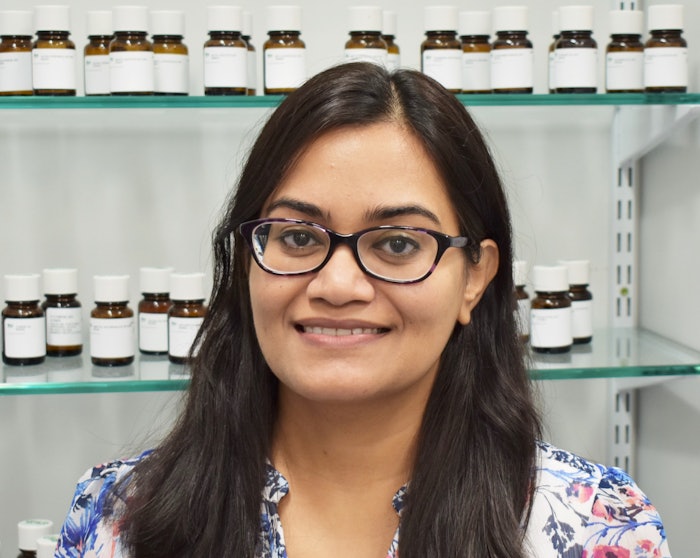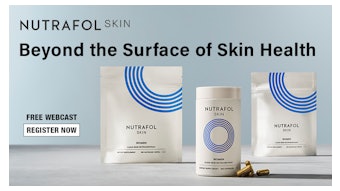
Name: Zareena Valappil, Ph.D.
Title: Senior Technical Director and Chief Global Flavorist, ADM
Current Location: Cranbury, New Jersey, USA
What led you to the flavor industry?
Zareena Valappil [ZV]: I grew up in India, which I consider the land of spices and amazing flavors. My first professional foray into flavors started when I was working in India for a research institute, where we studied the impact of food preservation methods on flavor profiles of spices, like saffron, turmeric, pepper and nutmeg. Even though my background and my master’s degree were in biochemistry, with this newfound interest in flavors, I came to the US to pursue my Ph.D. in Food Science at the University of Florida. That’s also where my passion for citrus started, because Florida is the center of the citrus industry. It was also during my doctoral studies that flavor chemistry started to intrigue me because it is so complex. Whether it is a fruit flavor or a savory flavor, the amount of complexity that nature incorporates is really astonishing. Initially, I started as a research scientist in R&D before transitioning into a flavorist role. I was hooked from day one of my flavor training and never looked back.
What applications do you primarily formulate for? Has this changed since you first began your career?
ZV: As flavorists, we typically get broad training in every type of flavor tonality and its application across all product categories; and there are a lot of flavorists who are generalists. Early on, though, I knew I wanted to specialize and my true passion is for citrus. Citrus is almost 50% of all beverage launches. Therefore, I typically formulate different types of beverages. Alcohol is one of my favorite categories, as citrus is always a key taste driver in alcohol launches.
Regarding the question of change, citrus, like other natural products, is impacted by market volatility in terms of cost, availability and quality. Citrus greening and weather fluctuations have impacted citrus, especially oranges, with declining production globally. So, as flavorists, we have to incorporate technology, like ADM’s CitrusFlex, and creativity in designing citrus flavors to ensure consumers get the same great-tasting citrus products with no compromise on quality or cost.
Over the years, I’ve also specialized in vanilla and have had opportunities to work in dairy, bakery and confections. Recently I’ve been working in the interesting category of taste modulation. Here we focus a lot on incorporating new innovations, helping to make food formulations healthier and more consumer preferred.
What are some of the current trends that are exciting you at the moment?
ZV: Today’s consumers are increasingly health conscious and they desire products, including beverages, with added functional benefits. So, we’re seeing a surge in products with reduced sugar or those that have functional ingredients added to them. However, when reducing sugar, for example, base challenges, such as off-notes or more bitterness or astringency, rise to the top, such that flavors have to work really hard to make the product appealing. Flavorists use many characterizing flavors and masking solutions to overcome these hurdles. At ADM, we’ve developed our own TasteSparka flavor modulation technology, which leverages our captive molecules to address these challenges.
I also find the globalization of flavors exciting. Gen Z consumers, in particular, are very aware of global cuisines and are enjoying new food experiences. They’re asking for savory twists like black lime or charred orange and unique citrus fruit profiles like yuzu, finger lime and Calamansi. This trending interest gives me an opportunity to push my creativity beyond the traditional.
Are there any formulations you would consider timeless? Why?
ZV: Cola is a timeless flavor. It’s true ingenuity. Somebody really thought outside the box, right? There was no reference for a cola flavor. It’s not like a fruit profile, such as orange or lemon; this was purely one of the first flavors that was created, and it was not something with which people were familiar. Like, who could have imagined? From a flavorist’s perspective, cola is a unique combination of citrus, vanilla and botanicals, and this mix creates a taste profile that is loved globally by consumers. Irrespective of the region, cola is one of the most popular profiles in beverages, and it continues to stand the test of time. Since it was developed in the 1880s, it is still one of the popular flavor profiles with which people are fascinated and continue to consume. Cola, for me, is one of those timeless flavor profiles that I return to.
Are the types of projects you're working on changing over time? How are the creative demands of the job evolving?
ZV: Absolutely everything is changing. The sheer number of products that are available on the market now is astounding. Before, you had three or four beverage choices, such as juice, carbonated soft drinks or milk. But now, you have new categories blooming every day like plant-based products, zero-alcohol beverages and food with functionality. It’s hard for one flavor to work across the board, and flavor toolboxes need to keep changing. If you add to that the challenges of raw material fluctuation, cost and the changing global regulatory landscape, these factors make a flavorist’s role quite daunting. But I also have never seen a flavorist who does not like a good challenge. For instance, I rely on new technologies, like ADM’s Corefoldb technology, to create bold and impactful flavors that can shine through any type of application. The dynamic nature of the food and beverage space keeps flavorists’ creativity going, as we cater to our customers’ needs, as well as to new markets.
Footnotes
aTasteSpark is a trademark of ADM
bADM’s Corefold is a trademark of ADM











